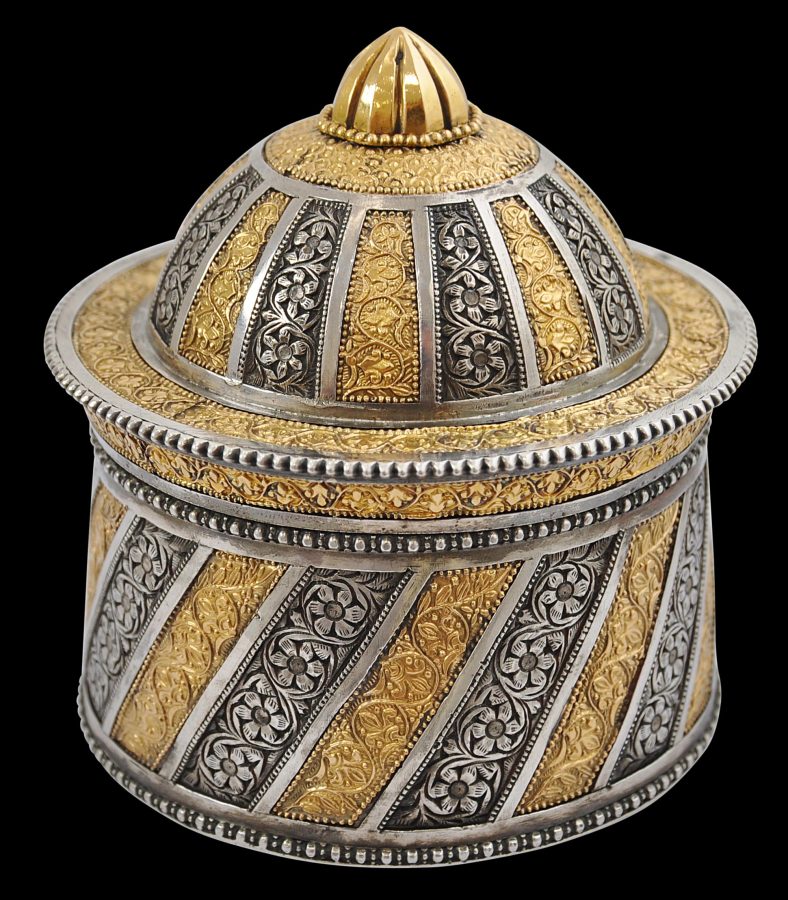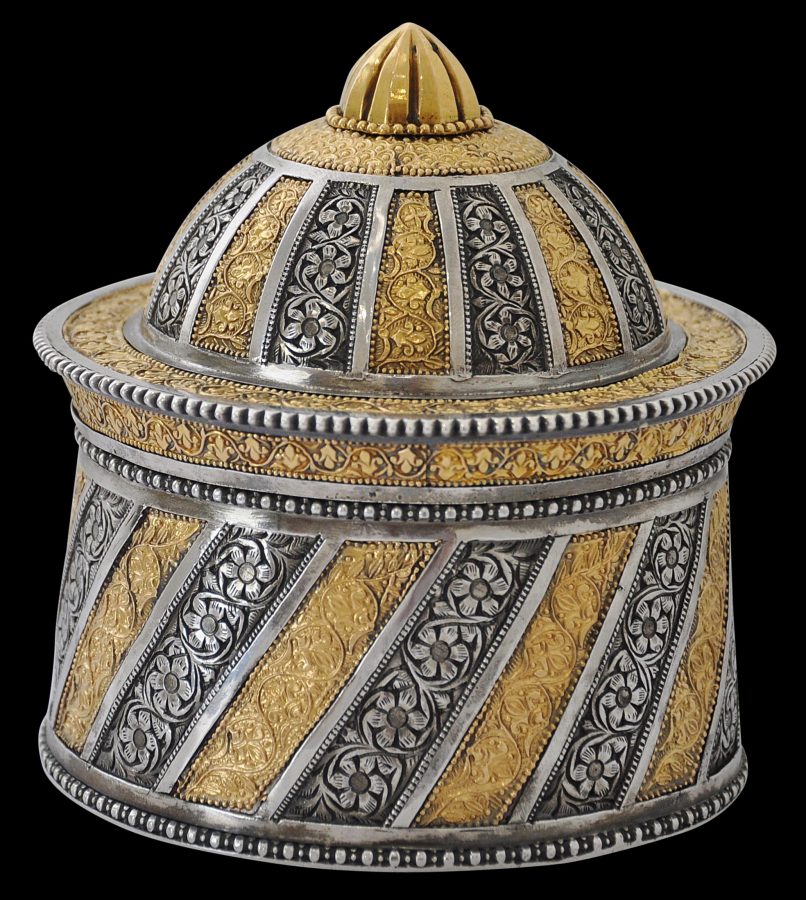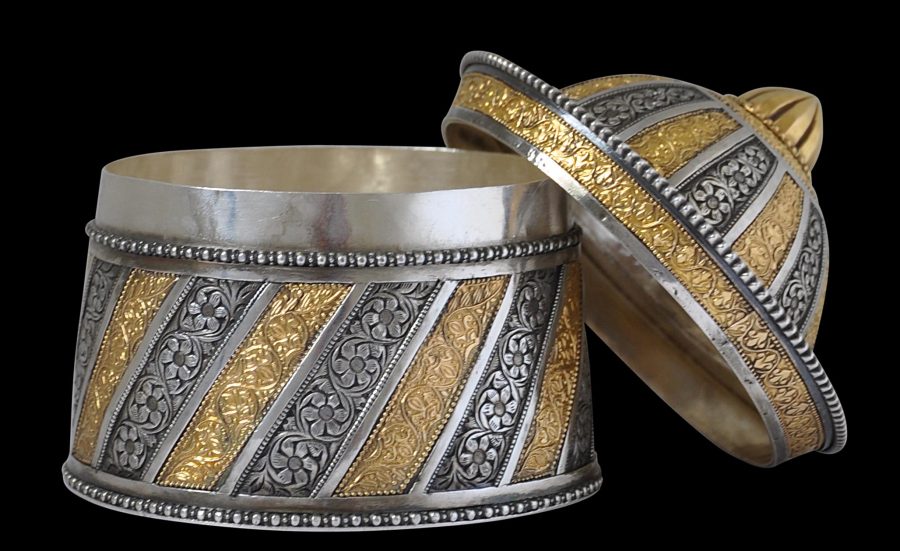Zanzibar items are rare – and yet Zanzibar was an important centre for trade especially in ivory, slaves, spices, grain and many other items. It linked the east coast of Africa to the Middle East and to India. As a consequence, it was an important centre for raw materials for the production of luxury goods that were subsequently traded around the world, including to Europe and the United States. It was ruled by an Islamic sultan installed in a local palace and as a consequence there was demand for local production of luxury goods as well, for the palace and related aristocrats and wealthy merchants and also to be given as diplomatic gifts. It is in this context that the gold and silver box here can be considered.
The box, most probably intended to serve as or based on a betel nut (tambuu) box, comprises a base and a tightly fitting domed lid. Both the base and the lid are of beaten silver that has been chased with a total of 17 separate panels of trellised flowers which radiate around the base and lid. They are separated by 20 inset panels of gold sheet, chased with trellised leaf motifs.
The lid is surmounted by a domed gold finial, and has an over-hanging rim. The silver edges of the base and lid have been ‘beaded’ or ‘pearled’. Overall, the box and cover have an Islamic architectural form.
We know of only one other similar box. That box comprised lot 406 of Sotheby’s London ‘Indian, Himalayan and South-East Asian Art’, November 23, 1987. The box at that time was catalogued (incorrectly) as Sinhalese and was attributed to the 18th-19th century. The Sotheby’s box was almost identical to the box here, although with a diameter of 9.5cm was significantly smaller. Importantly, that box had a gold band running around the lower part of the base (but not one running around the underside of the rim as our does) and that band was decorated with repeated circular sun-burst motifs. Inset gold plaques decorated with this motifs seems to be characteristic of Zanzibar work. Such panels can be seen on the ivory hilts of Omani-influenced sword that were manufactured in Zanzibar in the eighteenth century. Examples of these swords are illustrated in Hales (2013, pp. 237-139). The same panels also appear on an ivory hair comb that we had and which was attributable to Zanzibar and which is now in the collection of the Minneapolis Institute of Art (see here for the comb.) The Sotheby’s example with its gold plaques allows us to attribute the example here to Zanzibar.
Zanzibar comprises two larger islands and a series of smaller islands 25-50 kilometres off the coast of East Africa. Arab traders visited and traded with the islands for many centuries. In the 16th and 17th centuries, Zanzibar was under Portuguese control. And in 1698, it was sized by the Sultanate of Oman, and a ruling Arab elite with a local sultan was installed which developed the local economy further enhancing its trading links with the Middle East and with India.
Important trading communities of Muscat-descended Arabs and Indian Muslims established themselves in Zanzibar. The Indian Muslims comprised Ismailis – Khojas – and Bohoras particularly. Parsees from India also were another significant community. Another Muslim community, the Wahadimu, evolved too, by intermarriage between Africans and Arabs. Other groups included Ceylonese, Christian Goanese of Portuguese and Indian descent, and Indian Baluchis.
Zanzibar became renown as a source of ivory, spices and slaves. It also became a regional entrepot and was an important source of goods that were traded into Africa. The Sultan of Zanzibar also controlled parts of the East African coast which also facilitated this. By the mid-19th century, Zanzibar was the biggest slave centre in East Africa with around 50,000 slaves passing through its docks each year.
By the late 19th century, Zanzibar was under the control of the British. The islands gained independence from Britain in December 1963. A month later, the Republic of Zanzibar and Pemba was formed in a revolution that saw thousands of Arabs and Indians killed. The following April, the republic was subsumed into the mainland former colony of Tanganyika (later Tanzania). Zanzibar today has semi-autonomous status.
The box here is in perfect condition.
It came from the estate of Mary Crew-Milnes, the Duchess of Roxburgh and was kept at her country house, West Horsley Place, until her death in 2014. Her godmother was Queen Mary and her mother was a daughter of the Earl of Rosebery, a former British prime minister. Mary married the Duke of Roxburgh in 1935, although they later divorced.
References
Dale, G., The Peoples of Zanzibar: Their Customs and Religious Beliefs, The Universities’ Mission to Central Africa, 1920.
Hales, R., Islamic and Oriental Arms and Armour: A Lifetime’s Passion, Robert Hale CI Ltd, 2013.









